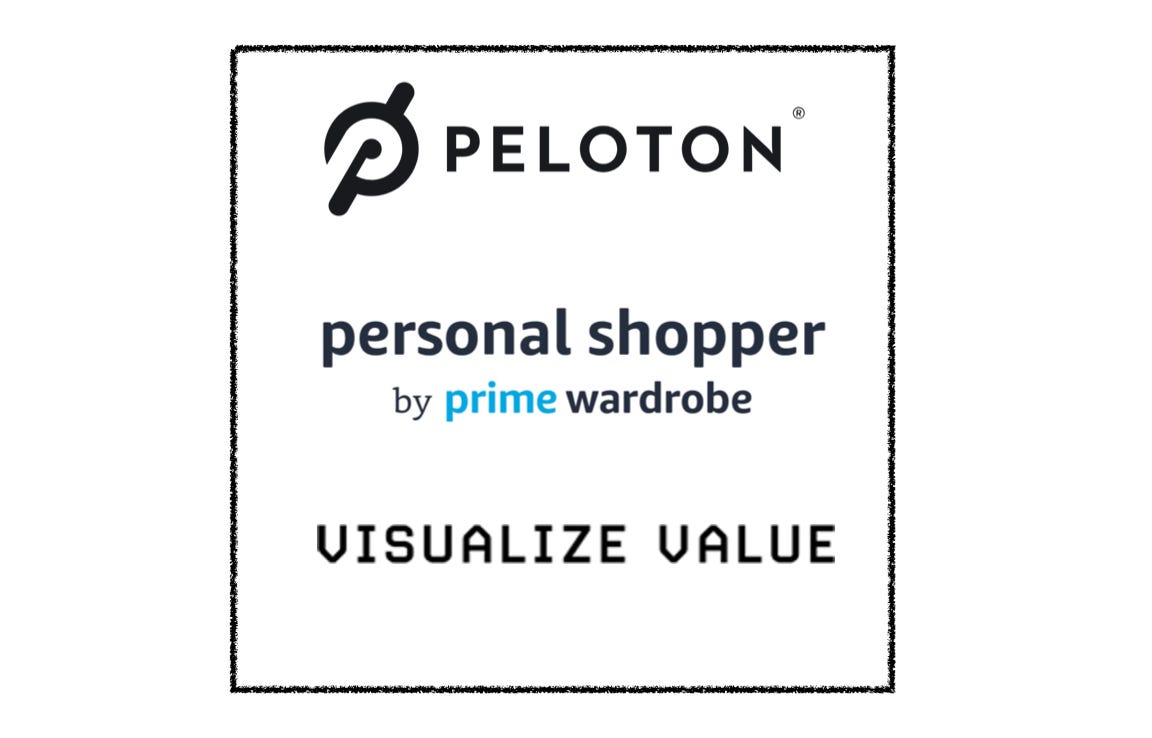Digest // 15
Peloton's Talent Flywheel, Amazon Personal Shopper, and Moving Down the Value Ladder
SaaS Pricing is hard. PricingSaaS is your cheat code.
Monitor competitors, track real-time benchmarks, discover new strategies, and more.
Happy Sunday y’all!
Rafael Nadal is one my favorite athletes, and today’s French Open final against Novak Djokovic was anticlimactic in the best way possible. Nadal took home his 13th title at Roland Garros in straight sets, improving his record there to 100-2 🤯.
With the win, he tied Roger Federer for the most majors of all time. One thing I’ve been meaning to do is rewatch their classic 2008 Wimbledon final, which many consider the best tennis match of all time. The whole thing is available on YouTube, clocking in at 6 hours and 13 minutes, which is probably why I haven’t gotten around to it yet...
This week’s digest is a mixed bag, covering an underrated ingredient of Peloton’s strategy, how Amazon’s Personal Shopper product and packaging differ from Stitch Fix, and breaking down one of my favorite packaging frameworks.
I would love your feedback! If you enjoy this post, do me a favor and click the “like” button up top (the heart). That way I’ll know which topics are resonating most.
On to this week’s analysis.
Briefing 📋
Peloton’s Talent Flywheel 🚴♀️: Peloton’s talent flywheel provides a playbook for attracting and retaining elite talent in the passion economy. They treat their teachers like professional athletes, give them access to the largest home-fitness audience in the world, and empower them to build their own personal brands outside the Peloton platform.
Amazon Personal Shopper vs Stitch Fix 👕: Personal Shopper is Amazon’s answer to Stitch Fix, but there are important differences. While the Stitch Fix model does a better job of reducing friction, Amazon’s order-preview feature may help increase retention in the first few orders when churn is especially likely.
Moving Down the Value Ladder ↓: Jack Butcher’s Visualize Value deconstructs big ideas into simple visual frameworks. One of my favorites is his take on the Value Ladder, a model he’s followed closely to productize his own services.
Peloton’s Talent Flywheel 🚴♀️
When people talk about the Passion Economy it’s usually through the lens of creators going independent and building their own brand. Another side that gets mentioned a lot less, is how established companies will react to this trend, and reshape their culture to empower and nurture creative talent.
Fundamentally, there’s an opportunity for organizations to give creators the freedom they need to thrive while offering the benefits and stability they wouldn’t be able to achieve on their own. The best piece I’ve read about this concept is Jarrod Dicker’s The Next Media Opportunity: Talent, Reputation and Lessons from Record Labels.
In the process of revamping The Peloton Pivot alongside Anuj Abrol of Witty Wealth, we realized that Peloton is already on the cutting edge here, and identified their talent flywheel as one of their greatest assets. Their talent flywheel is hugely important competitively, and highlights how companies in other industries can create a culture and support system to become a magnet for top talent.
First, Peloton creates the infrastructure to attract top talent. They famously treat their teachers like professional athletes, paying them for time off and offering weekly physical therapy.
Beyond that, they connect their talent to the largest home-fitness customer base in the world. Getting their talent in front of Peloton’s faithful allows them to connect with thousands of users and grow their own personal brand. That, in fact, is exactly what’s happened. Peloton’s teachers have become celebrities in their own right, with hundreds of thousands of followers across social media.
@emmalovewell - 270k Instagram followers
@alextoussaint25 - 273k Instagram followers
@codyrigsby - 386k Instagram followers
@AllymissLove - 440k Instagram followers
Social followings of this magnitude mean Peloton’s teachers have real influence, opening up new opportunities for them. For instance, Alex Toussaint is an advisor for Ladder, Lebron's Sports Nutrition Company, and has his own merch line. Ally Love built her brand through Ted Talks and is building out her own community, Love Squad.
These developments are great for Peloton. The more successful their teachers are, the more high-quality fitness talent will want to work there and follow this playbook. By pulling in new top-talent, they can further differentiate their classes, and drive even more passionate users.
It’s worth noting, Peloton could sign professional athletes as sponsors in an instant if they wanted to, but they consider their teachers the face of the brand. I believe this relationship with their talent is prescient, and a model that other companies can follow to create a mutually beneficial environment for creative talent as the passion economy matures.
Amazon Personal Shopper vs Stitch Fix 👕
At the end of September, Amazon made a move to strengthen their Prime Wardrobe product, expanding their Personal Shopper offering to include men’s fashion with classy-casual brands like Original Penguin, Carhartt, and Levi’s.
For the unfamiliar, Personal Shopper is Amazon’s answer to Stitch Fix. The service includes curation from in-house stylists, allowing customers to try on clothes at home, keep what they want, and return what they don’t. That said, there are some important differences between Amazon’s model and Stitch Fix.
First, Amazon Personal Shopper is charged as a $5 per month subscription. This fee entitles members to one styling per month. Alternatively, Stitch Fix offers delivery on flexible cadences, including 2-3 weeks, monthly, every other month, and every 3 months.
Along with flexible delivery schedules, Stitch Fix doesn’t charge a monthly subscription fee, opting instead for a $20 styling fee that’s reimbursed if you end up purchasing any of the items in your selection. In fact, they openly tout that they don’t require a subscription.

Further, while Stitch Fix offers 30 days to try on your fix, Amazon only allows a 7-day try-on period. Looking at all of this in a vacuum, the Stitch Fix model reduces friction far more than Amazon. This is somewhat surprising considering Amazon’s focus on delighting customers.
I think Stitch Fix has it right here - reducing friction is key because this product is hard. Recently, I tried Stitch Fix, and didn’t end up keeping anything. This is consistent with the experience my wife and other family members have had. Simply put, I’ve never met anyone who has tried Stitch Fix and stuck with it for the long haul.
[Note: If you have, I’d love to hear from you!]
Getting people to stick with these products is critical because every additional order improves the recommendation engine. If people are leaving after their first fix, Stitch Fix barely has a chance to show what they can do. It’s in this sense that I believe Amazon’s order preview feature could have a huge impact.
Before shipping, Amazon alerts customers with the styles in their order, giving them the chance to choose the items they want to try on, and discard the rest. This is something Stitch Fix doesn’t do with their fixes, likely because it would reduce the importance of their recommendation algorithm, and take away from the novelty of unboxing.
While that’s reasonable, I believe Amazon is on to something with their utilitarian approach. Simply put, they want to deliver goods that people want and increase the chances that they keep them. This seems like a novel solution to stifle early churn, and and boost customer LTVs in the long-run.
Moving Down the Value Ladder ↓
Last weekend, I devoured Eric Jorgenson’s Almanack of Naval Ravikant, which I really can’t recommend enough. In those pages, I couldn’t help but notice some familiar visuals. Jack Butcher, founder of Visualize Value, was tapped to add his unique visual style to the book. It worked, and it's the first time I’ve read a book that felt truly inspired by Twitter.
Beyond these illustrations, Jack Butcher has built an incredible business with Visualize Value, where he deconstructs big ideas with simple visual frameworks.
One of my personal favorites is Russell Brunson’s value ladder, a simple and intuitive product packaging framework. The value ladder buckets offerings into 3 tiers with escalating prices for each level:
Do it yourself: Give customers the tools to take action themselves (Product)
Do it together: Give customers the tools and the expertise to take action collaboratively (Productized Service)
Do it for you: Take action on behalf of the customer (Service)
I love this framework for its simplicity, and how easily it can be applied to large enterprises as well as individual creators like Butcher. Until recently, the Visualize Value product structure aligned well with Brunson’s value ladder, and Butcher captured the concept in a visual earlier this year.

Here’s how the 3 levels used to look:
Do it yourself: Butcher offers one-off purchases for playbooks and frameworks that give customers what they need to start their own path to independent income. An example is his Daily Manifest productivity framework.
Do it together: Butcher offers a Visualize Value annual membership which includes weekly office hours, a private Slack group, and a vault of private content, where members get more access to Butcher and can learn from like-minded builders. Members rave about the community, and learning opportunities.
Do it for you: Butcher used to offer a "done for you" content strategy called the Bespoke Trust Profile, where he would build custom strategies for customers to utilize for communication and audience engagement.
If you visit the Visualize Value shop right now, you’ll notice the Bespoke Trust Profile is gone. By getting rid of it, Butcher has followed his own advice, moving further down the value ladder by eliminating a pure service offering entirely.
While Butcher’s move is clearly applicable to individual creators, it’s also interesting to think about for larger enterprises. Divorcing time from money is basically another way of saying make your product more scalable. If your team is feeling overburdened with high-touch client engagements, it’s worth asking if there’s a way to move further down the ladder by productizing your labor-intensive services.
Enjoying Good Better Best?
If you enjoyed this post, I’d love it if you hit the “like” button, that way I’ll know which posts are resonating the most!
If you have thoughts or feedback, I’d love to hear from you! You can find me on Twitter here.







